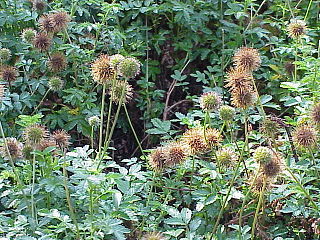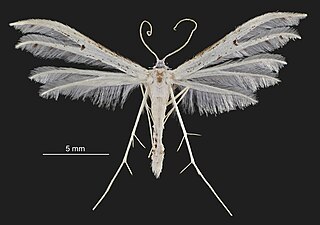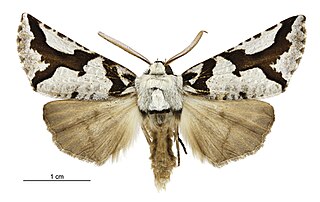
The Royal Horticultural Society (RHS), founded in 1804 as the Horticultural Society of London, is the UK's leading gardening charity.

Sophora microphylla, commonly known as weeping kōwhai and small-leaved kōwhai, is a species of flowering tree in the family Fabaceae native to New Zealand. It is the most widespread of the eight species of kōwhai. It is also called South Island kōwhai, although this name is misleading as it is widely distributed throughout the main islands of the country.

Hesperocyparis macrocarpa also known as Cupressus macrocarpa, or the Monterey cypress is a coniferous tree, and is one of several species of cypress trees endemic to California.

Araucaria heterophylla is a species of conifer. As its vernacular name Norfolk Island pine implies, the tree is endemic to Norfolk Island, an external territory of Australia located in the Pacific Ocean between New Zealand and New Caledonia. It is not a true pine, which belong to the genus Pinus in the family Pinaceae, but instead is a member of the genus Araucaria in the family Araucariaceae, which also contains the hoop pine. Members of Araucaria occur across the South Pacific, especially concentrated in New Caledonia, where 13 closely related species of similar appearance are found. It is sometimes called a star pine, Polynesian pine, triangle tree or living Christmas tree, due to its symmetrical shape as a sapling.

Acaena is a genus of about 60 species of mainly evergreen, creeping herbaceous perennial plants and subshrubs in the family Rosaceae, native mainly to the Southern Hemisphere, notably New Zealand, Australia and South America, but with a few species extending into the Northern Hemisphere, north to Hawaii and California.

Leonard Cockayne is regarded as New Zealand's greatest botanist and a founder of Western science in New Zealand.

Sphaeropteris medullaris, synonym Cyathea medullaris, commonly known as mamaku or black tree fern, is a large tree fern up to 20 m tall. It is distributed across the south-west Pacific from Fiji to Pitcairn Island. Its other Māori names include katātā, kōrau, or pītau.

Phoenix canariensis, the Canary Island date palm, is a species of flowering plant in the palm family Arecaceae, native to the Canary Islands off the coast of Northwestern Africa. It is a relative of Phoenix dactylifera, the true date palm. It is the natural symbol of the Canary Islands, together with the canary Serinus canaria.

Pseudopanax arboreus or five finger, is a New Zealand native tree belonging to the family Araliaceae. It is one of New Zealand's more common native trees, being found widely in bush, scrub and gardens throughout both islands. The compound leaves with five to seven leaflets, hence the common name, are very characteristic of the tree and easily recognized.

Phormium colensoi, also called mountain flax, or wharariki in Māori, is a perennial plant that is endemic to New Zealand. The greenish, yellow or orange flowers are followed by twisted seed pods. It is less common than the other Phormium species, P. tenax or harakeke. Mountain flax is also called whararipi, whatariki, mangaeka, kōrari tuauru, wauraki, coastal flax, hill flax and lesser New Zealand flax.

Neopanax is a genus of flowering plants in the family Araliaceae, native to New Zealand, including the Kermadec Islands. It is a clade within the genus Pseudopanax, and some authorities consider it to be a synonym of Pseudopanax.

Pseudopanax lessonii, or houpara, is a New Zealand native tree belonging to the family Araliaceae.

Coprosma repens is a species of flowering shrub or small tree of the genus Coprosma, in the family Rubiaceae, native to New Zealand. Common names include taupata, tree bedstraw, mirror bush, looking-glass bush, New Zealand laurel and shiny leaf.

Pseudopanax colensoi, commonly known as the mountain fivefinger in English and orihou in Māori, is an endemic species to New Zealand. It is a shrub that can often grow into a small canopy tree, and is found in high altitude environments in its preferred areas around New Zealand. It is a member of the Neopanax clade, and is referred to by some sources as Neopanax colensoi.

Pterophorus monospilalis, the white plume moth, is a moth of the family Pterophoridae. It is endemic to New Zealand and occurs throughout the country. It inhabits native forest, parks and domestic gardens. Larvae are active during the day, are slow moving, and feed exposed. They feed on Araliaceae species as well as on Hedera helix, Meryta sinclairii, and Schefflera digitata. There are several broods in a year. Adult moths are on the wing from November until May and are attracted to light.

Roderick Leon Bieleski was a New Zealand plant physiologist. As a botanist and horticulturist, his research focussed on understanding the factors that affected the behaviour of plants, in particular horticultural crops. His work had practical relevance to farmers and orchardists in building their understanding of these factors and taking account of them while making a living from growing and harvesting plants. He received many honours and awards, culminating in being appointed Member of the New Zealand Order of Merit (MNZM) in 2010.

Ipana egregia, commonly called the South Island lichen moth or zebra lichen moth, is a moth in the family Geometridae, endemic to New Zealand. This species was first described by entomologists Baron Cajetan von Felder and Alois Friedrich Rogenhofer in 1875 under the name Chlenias egregia.

Libertia chilensis, synonym Libertia formosa, called the New Zealand satin flower, snowy mermaid, or Chilean-iris, is a species of flowering plant in the iris family, Iridaceae, native to the Juan Fernández Islands, central and southern Chile, and southern Argentina. It can also be found growing wild in the San Francisco Bay Area and San Bernardino County in California, where it is an introduced species. A rhizomatous evergreen perennial, it has gained the Royal Horticultural Society's Award of Garden Merit.

Plectranthus ciliatus, called Indian borage, speckled spur flower, blue spur flower, and candlestick plant, is a species of flowering plant in the family Lamiaceae. It is native to South Africa and Eswatini, and introduced to Victoria in Australia and the North and South Islands of New Zealand. With its Coleus‑like foliage, its cultivar 'Easy Gold' has gained the Royal Horticultural Society's Award of Garden Merit as an ornamental.





















